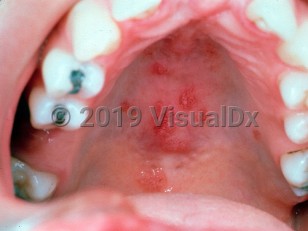Dry mouth (xerostomia) causes difficulty in chewing and swallowing and increases dental caries. Dryness also predisposes to oral candidiasis, which may cause a burning sensation and altered taste. One-third to one-half of patients have slightly tender enlargement of the bilateral salivary glands.
Dry eyes (xerophthalmia) presents as a gritty or foreign body sensation in the eyes and a predisposition to corneal ulceration.
Skin manifestations, which occur in about half of patients with SS, include xerosis (most common), Raynaud phenomenon, petechiae, palpable and nonpalpable purpura, urticarial vasculitis, annular erythema (lesions on the head and neck that can resemble subacute cutaneous lupus or Sweet syndrome), pernio-like lesions, and livedo reticularis. The presence of cutaneous vasculitis is associated with an increased risk of systemic involvement.
SS may present alone (primary SS), or it may be associated with other autoimmune diseases (secondary SS), such as lupus erythematosus or rheumatoid arthritis. Systemic manifestations of SS can arise in almost every organ system, such as muscle weakness, arthralgias, interstitial lung disease, autoimmune thyroiditis, and cytopenias. Rarely, interstitial cystitis may occur.
There are American-European Consensus Group criteria (AECG) and the American College of Rheumatology criteria for SS, which are mostly used for research purposes rather than clinical diagnosis. For reference, the AECG criteria include:
- Ocular symptoms – Daily, persistent, troublesome dry eyes for more than 3 months, recurrent sensation of sand or gravel in the eyes, and/or use of tear substitutes more than 3 times a day.
- Oral symptoms – Daily feeling of dry mouth for more than 3 months, recurrently or persistently swollen salivary glands (as an adult), and/or frequent intake of liquids to aid in swallowing of dry foods.
- Ocular signs – Positive result for Schirmer's test or Rose Bengal score (or other ocular dye score).
- Histopathology – A positive salivary gland biopsy confirms the diagnosis of SS; see Best Tests section for details.
- Salivary gland involvement by measurement of decreased salivary flow.
- Autoimmune antibodies – Presence in the serum of antibodies to Ro/SSA, La/SSB, or both.



